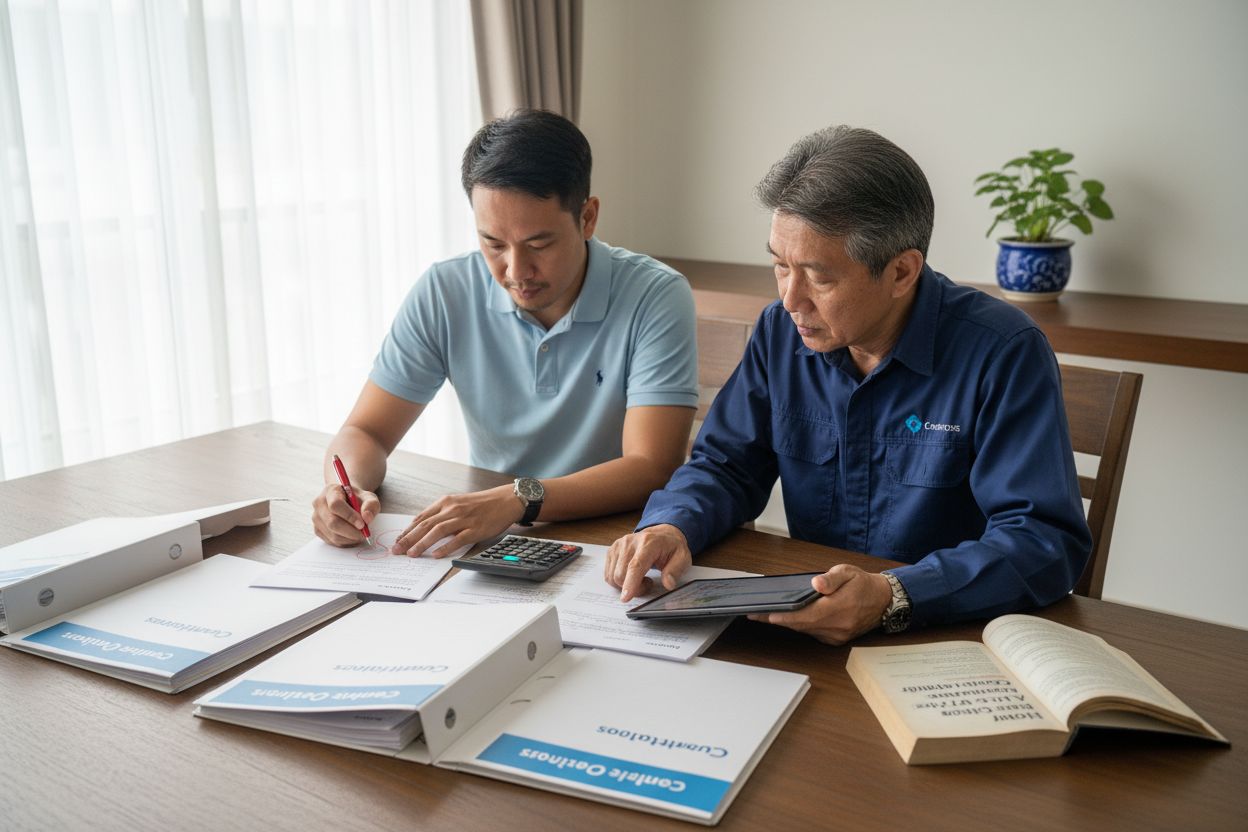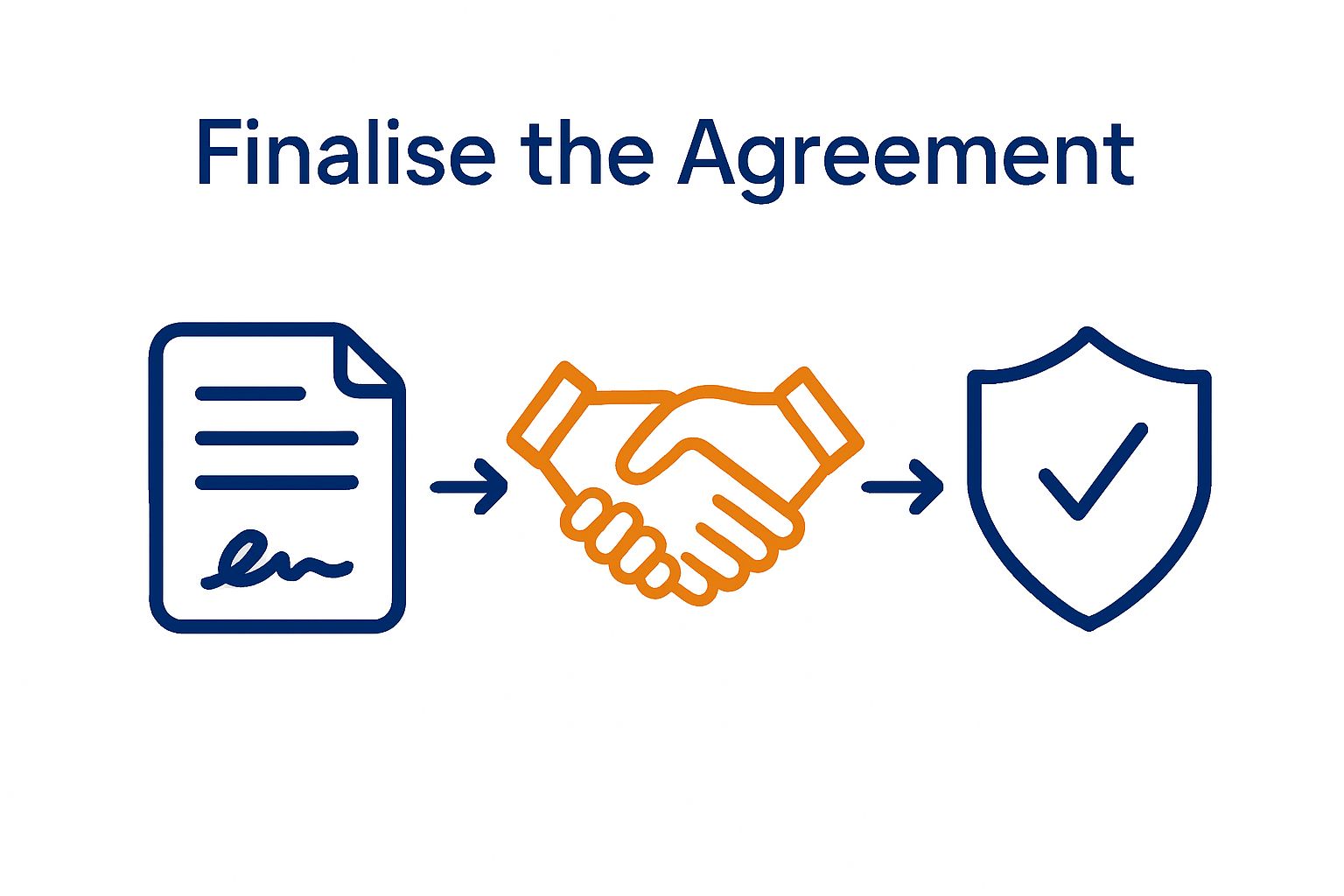
Blog
How to Choose Contractors: A Step-by-Step Guide | RumahHQ

Picking the right contractor can shape your entire renovation or building project. Studies show that clearly defined project requirements can reduce misunderstandings and disputes by up to 50 percent. Many people think a good contractor is just about price or reputation but that is only half the story. The real difference starts with how you set your groundwork from the very beginning and most people miss the small details that make all the difference.
Table of Contents
Quick Summary
| Key Point | Explanation |
|---|---|
| 1. Define clear project requirements | Outline specific goals, budget, and timeline to guide contractor selection and minimise misunderstandings. |
| 2. Research contractors thoroughly | Use personal recommendations and professional resources to identify qualified contractors with proven track records. |
| 3. Verify credentials and references | Check licenses and insurance, and speak to previous clients to ensure reliability and quality of work. |
| 4. Compare detailed quotations | Evaluate multiple bids for clarity, completeness, and alignment with your project’s needs beyond just price. |
| 5. Assess communication and rapport | Effective communication and a good personal connection with the contractor are crucial for a smooth project experience. |
Step 1: Define Your Project Requirements
Successfully choosing the right contractor begins with crystal clear project requirements. This foundational step determines the entire trajectory of your construction or renovation journey. When you articulate your project needs precisely, you create a roadmap that helps potential contractors understand exactly what you want, reducing misunderstandings and potential conflicts down the line.
Starting your project definition requires comprehensive self-assessment. Consider the specific outcomes you want to achieve. Are you planning a complete home renovation, building an extension, or undertaking specific repairs? Each project type demands different skills, expertise, and resources. Your project requirements should include detailed specifications about scope, desired quality, expected timeline, and budget constraints.
To develop a robust project definition, gather comprehensive information about your specific needs. Document every aspect meticulously, from structural requirements to aesthetic preferences. For instance, if you are renovating a kitchen, specify exact dimensions, preferred materials, desired appliance placements, and any unique design elements. The more precise your documentation, the easier it becomes for contractors to provide accurate quotes and understand your vision.
According to the National Association of Home Builders, clear project requirements help streamline contractor selection and minimize potential miscommunications. Professional contractors appreciate clients who come prepared with well-defined project parameters. Your documentation should include sketches, reference images, material preferences, and any specific technical requirements that might impact the project’s execution.
Consider creating a comprehensive project brief that includes:
- Exact project dimensions and specifications
- Preferred materials and quality standards
- Budget range and financial limitations
- Desired project completion timeline
- Any unique constraints or considerations
Remember that flexibility alongside clear requirements is crucial. While being specific helps contractors understand your vision, allowing some room for professional input can lead to innovative solutions and potentially improved outcomes. Your goal is to communicate your vision clearly while remaining open to expert recommendations that might enhance your original concept.
Step 2: Research Potential Contractors
Researching potential contractors transforms your project from a vague concept into a tangible reality. This critical step moves you beyond initial project requirements and helps you identify professionals capable of bringing your vision to life. The goal is not just finding a contractor but discovering a skilled partner who understands your specific needs and can deliver exceptional results.
Professional research requires a multifaceted approach that goes beyond simple internet searches. Begin by leveraging professional networks, local construction associations, and recommendations from trusted sources. Friends, family members, and professional colleagues who have recently completed similar projects can provide invaluable insights. Personal recommendations often reveal contractors with proven track records and reliable workmanship that might not be immediately apparent through online listings.
Local construction industry associations and professional licensing boards offer robust resources for verifying contractor credentials. These organisations maintain records of licensed professionals, their specialisations, and any registered complaints or disciplinary actions. Checking these official sources helps you eliminate unqualified or potentially problematic contractors before investing significant time in discussions.
In the digital age, online platforms provide additional research opportunities. Explore contractor websites, review platforms, and professional portfolios. Look for detailed project galleries, client testimonials, and transparent information about their expertise. Pay attention to contractors who demonstrate consistent quality, professional communication, and a comprehensive understanding of projects similar to yours.
Compiling a shortlist requires careful evaluation. Learn more about selecting top contractors in our comprehensive guide that can help you navigate potential pitfalls. Your research should include verifying:
- Professional licensing and certifications
- Years of experience in similar project types
- Documented project portfolios
- Client references and testimonials
- Insurance and bonding status
Remember that thorough research is an investment in your project’s success. Take time to validate each potential contractor’s credentials, communicate openly, and trust your instincts. A contractor who demonstrates transparency, professionalism, and genuine interest in understanding your project requirements is more likely to deliver outstanding results.
Step 3: Verify Credentials and References
Verifying credentials and references represents the most critical safeguard in your contractor selection process. This meticulous step transforms preliminary research into concrete validation, ensuring the professionals you are considering possess the genuine expertise and reliability required for your project. Credential verification goes far beyond simply checking a professional licence number it involves a comprehensive assessment of a contractor’s professional integrity and capability.
Initiate your verification process by requesting and meticulously examining official documentation. Professional licences, insurance certificates, and registration documents provide fundamental proof of a contractor’s legitimacy. Contact the issuing authorities directly to confirm the authenticity of these credentials. Some contractors might present impressive paperwork, but independent verification protects you from potential misrepresentations.
Reference checks offer a deeper insight into a contractor’s actual performance. Do not limit yourself to reading printed testimonials requesting direct conversations with previous clients provides unfiltered perspectives about the contractor’s work quality, communication style, and project management skills. When speaking with references, ask specific questions about project complexity, adherence to timelines, budget management, and how the contractor handled unexpected challenges.
According to the Construction Industry Authority, comprehensive background checks are essential for protecting homeowners from potential professional misconduct. Professional references should ideally represent projects similar to yours in scope, complexity, and design. Pay attention to how previous clients describe their overall experience beyond just the technical execution of the work.
Your verification process should systematically document the following critical elements:
- Valid professional licensing status
- Current professional insurance coverage
- Verifiable references from similar project types
- Financial stability and business track record
- Any professional disciplinary records or legal disputes
Remember that thorough verification is not about finding a perfect contractor but identifying a reliable professional who demonstrates transparency, competence, and genuine commitment to quality workmanship. Trust your instincts and do not hesitate to ask direct, challenging questions. A truly professional contractor will welcome thorough scrutiny and appreciate clients who are invested in understanding their capabilities.
The table below summarises the essential elements to verify when checking a contractor’s credentials and references, helping ensure you engage a reliable and competent professional for your project.
| Verification Element | What to Check | Why It Matters |
|---|---|---|
| Professional Licensing Status | Valid, current licence | Confirms legal right and industry recognition |
| Professional Insurance Coverage | Up-to-date insurance certificates | Protects you from liability and project risks |
| Relevant Client References | Direct conversations with past clients | Assesses reliability and work quality |
| Business Financial Stability | Track record and longevity | Indicates reliability and project continuity |
| Disciplinary or Legal Records | No history of disputes or misconduct | Reduces risk of potential issues |
Step 4: Obtain and Compare Quotations
Obtaining and comparing quotations transforms your project planning from conceptual to tangible. This critical step reveals not just potential costs but the depth of understanding each contractor has about your specific project requirements. Quotations are more than price tags they are comprehensive documents that reflect a contractor’s professional approach, technical comprehension, and commitment to transparent communication.
Request detailed written quotations from at least three verified contractors. These documents should provide comprehensive breakdowns of materials, labour, timeline, and potential additional costs. A professional quotation goes beyond a simple price list it should include precise project specifications, material quality descriptions, estimated completion dates, and payment schedule structures. Be wary of quotations that appear vague or lack specific details.
Comparing quotations requires a systematic approach that looks beyond the bottom-line price. Analyse each quotation for completeness, clarity, and alignment with your original project requirements. Look for contractors who provide granular details about their proposed approach, including specific materials, technical methodologies, and potential contingency planning. Significant variations between quotations might indicate differences in understanding your project scope or varying quality standards.
According to the Malaysian Construction Industry Development Board, comprehensive quotation comparison involves evaluating multiple aspects beyond mere pricing. Consider the following critical elements when reviewing quotations:
- Detailed scope of work description
- Specific materials and quality standards
- Labour and installation costs
- Project timeline and milestone descriptions
- Payment schedule and terms
- Warranty and post-completion support
Remember that the lowest price does not always represent the best value. A slightly higher quotation might include superior materials, more comprehensive warranty coverage, or more experienced project management. Engage contractors in open discussions about their quotations, seeking clarification on any unclear points. A professional contractor will welcome your detailed questions and provide transparent explanations.

Your goal is to select a quotation that offers the best overall value comprehensive quality, reasonable pricing, clear communication, and alignment with your project vision. Trust your research and verification process, and do not be afraid to negotiate or request modifications to ensure the quotation meets your exact requirements.
Step 5: Assess Contractor Communication and Rapport
Assessing communication and rapport represents a pivotal moment in selecting the right contractor. This step transcends technical competence and delves into the interpersonal dynamics that can make or break your entire project experience. Effective communication determines how smoothly your construction or renovation journey will progress, revealing a contractor’s professionalism, responsiveness, and commitment to understanding your vision.
Initiate your assessment through structured interactions that test the contractor’s communication skills. Pay close attention to response times, clarity of explanations, and their ability to articulate complex technical concepts in understandable language. A professional contractor should demonstrate active listening, ask insightful questions about your project, and provide comprehensive yet digestible information. Beware of professionals who speak in technical jargon without explaining concepts or those who seem dismissive of your specific project requirements.
During initial consultations, observe how potential contractors handle your queries. Do they provide detailed, thoughtful responses? Are they patient in explaining technical aspects? Do they show genuine interest in your project beyond its potential financial value? Learn more about navigating home construction challenges with our comprehensive building guide, which offers additional insights into effective contractor interactions.
According to the Construction Industry Development Board of Malaysia, effective communication involves more than verbal exchanges. Consider evaluating these critical communication indicators:
- Responsiveness to messages and queries
- Clarity and transparency in project explanations
- Willingness to provide detailed documentation
- Professionalism in addressing potential concerns
- Ability to explain complex technical processes simply
Rapport building goes beyond mere professional courtesy. Look for contractors who demonstrate emotional intelligence, showing they understand the personal significance of your project. A contractor who can balance technical expertise with genuine empathy will likely provide a more collaborative and satisfying project experience. Trust your instincts during these interactions. If something feels uncomfortable or unclear, it likely indicates potential future communication challenges. Your goal is to select a contractor who not only possesses technical skills but can also communicate effectively, making your project journey smooth and transparent.
Step 6: Finalise the Contractor Agreement
Finalising the contractor agreement represents the critical transition from discussion to commitment. This legal document serves as the blueprint for your entire project, establishing clear expectations, responsibilities, and protection for both parties. A comprehensive agreement eliminates ambiguity and provides a structured framework for project execution, preventing potential misunderstandings and conflicts.
Prepare for agreement finalisation by ensuring every aspect of your project is meticulously documented. The agreement should include detailed specifications about project scope, precise material requirements, comprehensive timeline with specific milestones, payment schedules, and explicit provisions for potential variations or unexpected challenges. Professional contractors will welcome thorough documentation as it demonstrates mutual respect and commitment to transparent collaboration.
Carefully review all contractual terms, paying exceptional attention to clauses related to project modifications, payment structures, and dispute resolution mechanisms. Do not hesitate to seek legal consultation to understand complex legal terminology. A well-structured agreement protects your interests by clearly defining expectations, performance standards, and remedial actions in case of project deviations.

According to the Construction Industry Development Board of Malaysia, a robust contractor agreement should comprehensively address several critical elements:
- Detailed project specifications and technical requirements
- Precise project timeline with specific milestone dates
- Comprehensive payment schedule and conditions
- Material quality standards and procurement responsibilities
- Warranty terms and post-completion support provisions
- Dispute resolution and contract termination clauses
Negotiation is an integral part of agreement finalisation. Approach discussions collaboratively, understanding that a fair agreement benefits both parties. Be prepared to compromise on minor details while maintaining firm boundaries on critical project requirements. A professional contractor will appreciate clients who are thorough, fair, and transparent during the negotiation process.
Remember that the signed agreement is more than a legal document it is a mutual commitment to your project’s success. Take time to read and understand every clause, ask questions about anything unclear, and ensure you are completely comfortable with the terms before signing. Your diligence during this stage sets the foundation for a successful, collaborative project journey.
Here is a checklist table you can use when reviewing and negotiating your final contractor agreement, ensuring all critical aspects are addressed and clearly documented before signing.
| Agreement Item | Description | Confirmed (✓/✗) |
|---|---|---|
| Project Specifications & Requirements | Detailed scope, technical needs, and standards | |
| Timeline & Milestone Dates | Clear project phases and completion deadlines | |
| Payment Schedule & Terms | Agreed instalments and payment triggers | |
| Material Quality Standards | Defined grades and sourcing responsibility | |
| Warranty & Post-Completion Support | Warranty period and support offered | |
| Dispute Resolution & Termination | Steps for resolving issues or ending contract |
Ready to Take the Stress Out of Hiring a Contractor?
Choosing the right contractor can feel overwhelming. Navigating quotations, verifying credentials, and ensuring you get quality service without being misled often leaves homeowners feeling vulnerable and uncertain. This guide has shown you how vital clear project requirements, careful research, and strong communication are for a successful build. Now, imagine if you could simplify every step using a trusted, all-in-one solution.

Let RumahHQ take the uncertainty out of building or renovating your home. Our platform streamlines the entire process, from preparing transparent quotations and managing compliance to offering free design consultations and structure warranties. Whether you are a first-time homeowner or working within a budget, our step-by-step project workflow keeps you informed and protected at every stage. Do not wait and risk costly mistakes. Visit RumahHQ today and experience how easy and secure your home journey can be. If you want specific guidance on getting project approvals, check out our insights here.
Frequently Asked Questions
How do I define my project requirements when choosing contractors?
To define your project requirements, start by detailing the specific outcomes you wish to achieve, such as renovations or repairs. Document all aspects, including dimensions, desired materials, budget constraints, and timelines to create a comprehensive project brief for contractors to reference.
What should I look for when researching potential contractors?
When researching potential contractors, focus on verifying their credentials, reading client testimonials, and examining project portfolios. Compile a list of at least three contractors who meet your criteria and have experience with similar projects.
How can I verify a contractor’s credentials and references?
To verify a contractor’s credentials, request official documentation like their professional licence and insurance certificates, then confirm their authenticity. Speak directly with previous clients about their experiences to gain insights into the contractor’s reliability and work quality.
What details should I expect in contractor quotations?
Contractor quotations should include a comprehensive breakdown of materials, labour costs, estimated completion dates, and clear payment schedules. Ensure that the quotations address your specific project requirements and provide details relevant to your project’s scope.
How can I assess communication and rapport with a contractor?
Assess communication and rapport by monitoring response times and the clarity of answers during initial interactions. Look for contractors who listen actively and explain technical concepts in an understandable way, which indicates their professionalism and dedication to your project.
What key elements should be included in the contractor agreement?
A contractor agreement should detail the project’s scope, timeline, payment schedule, and any provisions for changes or unexpected challenges. Review all terms carefully, ensuring that expectations and responsibilities are clearly outlined to prevent misunderstandings during the project.
Recommended
kontraktor rumah
bina rumah
pinjaman lppsa
pengeluaran kwsp
spesifikasi rumah
rumah batu-bata
pelan rumah
rekabentuk rumah
bina rumah atas tanah sendiri
kontraktor rumah selangor
rumah banglo
Source link











